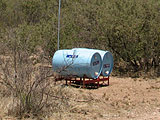US, Mexico: Litter Saves Lives
By Samuel Logan for ISN
A volunteer with Phoenix-based humanitarian organization, external pageNo More Deathscall_made, was arraigned on 9 February for littering. He had left gallon-sized jugs of water at strategic points along a trail normally used by illegal immigrants. The jugs are like an answered prayer to people dying of thirst, but to law enforcement, they are litter.
His case underlines the gap between law enforcement and human rights in a brutally hot border region where the laws of nature enforce the law of the land and humanitarian groups seek to intervene to save lives.
Pima County, Arizona sits on the border with the Mexican state of Sonora, just west of Tuscon and southwest of Phoenix. In the summer months, the temperature rises to 120 degrees. According to local Customs and Border Patrol (CBP) agent Mike Scioli, illegal immigrants crossing through the desert in Pima County require one gallon of water per person per hour to survive. But the trek can take as long as a week; it is impossible for anyone to carry that much water.
Since 2001, Pima County has supported the maintenance of water tanks, dispersed around the desert. One local humanitarian group, external pageHumane Borderscall_made, maintains some 97 watering stations in the area, and continues to enjoy county level support with annual grants of up to US$25,000 to maintain the tanks.
Keeping the tanks full is cheaper than the alternative: recovery, storage, identification, and repatriation of the dead bodies often found in the desert. In the first 11 months of the Border Patrol’s 2008 fiscal year, some 150 bodies, down from the 2005 peak of 197 deaths. Still, Pima County taxpayers spent US$138,394 during the 2005-2006 fiscal year to process bodies, according to the Arizona Daily Star, a Tucson-based daily.
But the tanks are simply not enough for the high number of immigrants that brave the desert every year. Some groups simply put up signs, warning travelers of the dangers of the desert. Other groups organize hikes, hoping to run into immigrants, offer assistance, and then escort them back to the nearest border crossing. No More Deaths, as well as others, sets up smaller watering stations, where one-gallon jugs are just enough to keep someone alive long enough to get out of the desert.
Scioli agrees that the watering stations set up by Humane Borders serve a purpose, but he has two caveats. They facilitate the role of human smugglers who can rely on the stations to move their human cargo through the desert. Bandits, who wait for their prey at watering stations, have also been a problem.
But many coyotes, the term used to describe the guides that lead illegal immigrants through the desert, lie to the people they're bringing across the border. They claim the trek will only take two to three hours, forcing the men, women and children who rely on them into a deadly situation with little more than one gallon of water.
Pima County straddles some of the most inhospitable country in Arizona. The desert kills, making this stretch of the border an ideal spot to test the so-called virtual fence: essentially cameras sitting on top of towers spaced equidistantly along the borderline.
There are 23 towers in Pima County, and officials there have requested that cell antennas be placed on the towers. A 911 service that spans across the desert appears to be a compromise position between a minority group of local humanitarian activists, who consider illegal immigrants humans before illegals, and what appears to be a fiercely anti-immigrant majority that seeks to remove the watering stations and decry support for federal law enforcement efforts determined to stop illegal immigration in the region.
So far, however, legal efforts to force Humane Borders to remove its water tanks from the desert have failed. Individuals in the desert, who volunteer to remove litter from well-traversed trails, leave water jugs, and assist the occasional immigrant they find, remain subject to the law. It is where leaving water to save a life is still considered littering.
The Tucson Sector is one of the most trafficked border crossing zones in the US. There are some 3,300 CBP agents in place to prevent illegal immigration and rescue stranded and dying immigrants. The CBP maintains a group specially trained agents for these missions, called Borstar, who focus on search and rescue in the desert. They work on the hottest days, save lives and send home everyone they save. But they need help.
Hundreds of thousands of illegal immigrants attempt to cross through the desert every year, where the frontier is open land, barely patrolled only by cameras on a tower. The CBP can’t possibly arrest all those who cross into the US. Nor can they expect to save everyone who is dying of thirst, yet when individual volunteers are arrested for leaving water jugs on the desert, the unnecessary enforcement of a minor law exemplifies how and why the federal government can’t possibly stymie the tide of illegal immigration alone.
The legal line between arresting someone for aiding and abetting an illegal immigrant and saving a life is thin, but when well-intentioned volunteers are arrested, the federal government forces itself farther away from civil society – perhaps the only group in the border region that can help them accomplish their mission.

